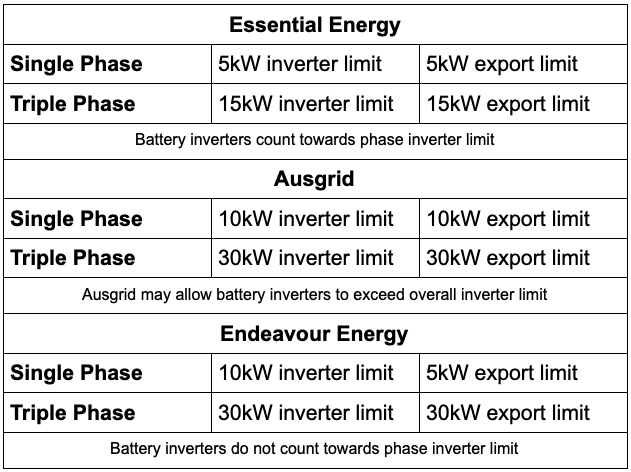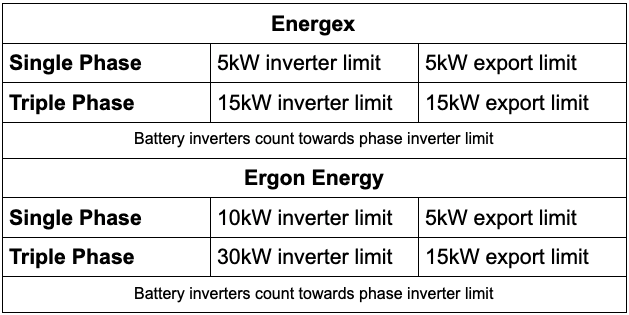One of the first questions you’ll ask yourself when you’re considering going solar is, “What size solar system should I install?”
It’s a question that can seem complicated at first. But there are really only a couple of factors that need to be considered. How much power do you need? How many panels can you fit on your roof? And what size system can you get approval for?
That’s it. Once you know the answers to those questions, you can go ahead and pick the system that will maximise your savings.
In this article, we’ll focus on the factor that many people struggle with – the grid approval process.
It’s important to be aware that the grid power distributor will only approve systems up to a certain size. Why? Well, it’s because Australia’s power infrastructure was only designed to send power in one direction. Sending too much in the other direction will cause problems. And so, the grid sets limits.
If you’re the kind of person that just wants the numbers, feel free to skip straight to the bottom of this blog where you can find the exact limits for your area. Or, if you’d rather talk to a human about your system, go ahead and book a free consultation and let our experts figure it out for you!
But if you want to understand this a bit more, let’s go through the basics.
What Size Solar System Should I Install?
This is not a simple question. But it’s not as complicated as it seems either. There are basically three questions to ask, and you should ask them in this order:
1. How Much Power Do I Need?
Check your bill to see how much power you’re using each day. It should appear near the price as “daily kWh”. Then, ideally, choose a system that can produce that much power or more.
You can also choose a system smaller than your total energy usage. You should still see a reduction in bills. But a large enough system can reduce your grid energy usage to nearly nothing. And if you ask us, that’s a worthwhile goal! Not only will it smash your energy bills by up to 90% or more, it’s also cleaner and more sustainable.
2. How Many Panels Can You Fit On Your Roof?
If you have a limited amount of roof space, that will limit the size of your system. That’s a question best handled by our solar experts. Book a free chat, and our engineers will look at satellite photography of your home to analyse size and placement.
However, if you have plenty of roof space, and you can fit enough panels to cover your power needs, it’s time to consider the last question…
3. What Is The Grid Limit?
This is the final question to be considered, and it needs a little more detail.
Understanding Grid Limits
When you install a solar system in your home, you have to get approval from the grid. That’s a necessary reality. And it’s also one of the things that can limit the size of your system.
Why does the grid limit the size of your solar system? Shouldn’t that be up to you? In a perfect world, maybe. But we’re working within the constraints of our existing infrastructure.
When the grid was designed, it wasn’t intended to have power flowing in both directions. It can handle some power flowing back from homes, but not an unlimited amount. And that’s why we have size limits from the grid. If too much power comes from home solar systems, it can cause all kinds of problems. We’re talking blackouts, brownouts, and even technicians getting zapped while working on the lines.
The key factors here are inverter limits and export limits. Put simply, your inverter limit tells you how much AC power you can send to the grid from all of your system’s inverters. That includes battery inverters, solar inverters, and hybrid inverters. The export limit tells you how much power you’re allowed to send back to the grid at any one time.
So, when you’re choosing your system, it’s important to remember that you have to stay within these limitations.
Let Us Help You
It is technically possible to get a system approved outside of these limits. However, this will usually result in delays and a lot of red tape to figure out. We usually advise our customers to find the best solution that complies with their provider’s limitations.
The key thing to remember is this: The grid limits are generous, and many of our customers are able to cut their energy bills by up to 90% or more.
If you want to get stuck into the nitty gritty of grid limits, feel free to look through the chart below*. But our experts can also design a system that will get approved quickly and maximise your savings!
Book a free consultation to get started on your system today!

NSW

QLD

SA

VIC
*This is just a reference, the policy of each grid is constantly updated, the final result is subject to the grid approval received

